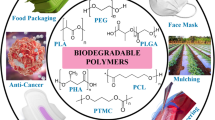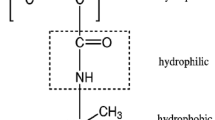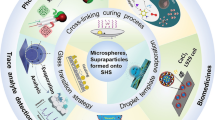Abstract
Healthcare industry is one of the major consumers of surface-modified polymer nanoparticles (NPs). If an incorporation of the stimuli-responsive polymers to such NPs is achieved, it can potentially broaden the range of their applications tremendously. In this work, an emulsifying ability of poly(methacrylic acid) (PMAA) and a series of its random methyl methacrylate (MMA) copolymers (PMAA-co-PMMA) prepared by free-radical polymerization was studied. It was found that these random copolymers and PMAA homopolymer could act as the surfactants (at certain pH values) in aqueous emulsion polymerization of MMA, which produces spherical PMMA NPs with carboxylic groups on the particles' surface. With the help of 1H NMR analysis it was determined that the PMMA NPs synthesized in this manner had 9.6 wt% PMAA (or PMAA-co-PMMA) coating, and due to that, the aqueous dispersions of these NPs exhibited pH-responsiveness. Although all the dispersions prepared were pH-responsive, only PMAA15-co-PMMA85/PMMA latex was found to be CO2-responsive: this sample could undergo CO2-triggered aggregation and N2-triggered redispersion. This newly developed method of preparation of smart NPs functionalized with carboxylic acid groups is uncomplicated and provides an environmentally friendly way of adjusting the dispersions' properties using gases only, avoiding the necessity of acids and bases addition.










Similar content being viewed by others
References
Feuser PE, Gaspar PC, Ricci-Júnior E, Silva MC, Nele M, Sayer C, de Araújo P HH (2014) Synthesis and characterization of poly (methyl methacrylate) PMMA and evaluation of cytotoxicity for biomedical application. Macromol Symp 343:65–69
Bettencourt A, Almeida AJ (2012) Poly (methyl methacrylate) particulate carriers in drug delivery. J Microencapsul 29:353–367
Khan FA, Akhtar S, Almohazey D, Alomari M, Almofty SA, Badr I, Elaissari A (2019) Targeted delivery of poly (methyl methacrylate) particles in colon cancer cells selectively attenuates cancer cell proliferation. Artif Cells Nanomed Biotechnol 47:1533–1542
Li S, Hu J, Liu B (2004) Use of chemically modified PMMA microspheres for enzyme immobilization. Biosystems 77:25–32
Valério A, Nicoletti G, Cipolatti EP, Ninow JL, Araújo PH, Sayer C, de Oliveira D (2015) Kinetic study of Candida antarctica lipase B immobilization using poly (methyl methacrylate) nanoparticles obtained by miniemulsion polymerization as support. Appl Biochem Biotechnol 175:2961–2971
Sathish S, Ishizu N, Shen AQ (2019) Air plasma-enhanced covalent functionalization of poly (methyl methacrylate): high-throughput protein immobilization for miniaturized bioassays. ACS Appl Mater Interfaces 11:46350–46360
Schmidt C, Borcherding H, Thiele T, Schedler U, Werner F, Rödiger S, Roggenbuck D, Schierack P (2021) Fluorescence-encoded poly (methyl metharcylate) nanoparticles for a lateral flow assay detecting IgM autoantibodies in rheumatoid arthritis. Anal Biochem 633:114389
Juneja R, Roy I (2014) Surface modified PMMA nanoparticles with tunable drug release and cellular uptake. RSC Adv 4:44472–44479
Young BP, Shin JJH, Orij R, Chao JT, Li SC, Guan XL, Khong A, Jan E, Wenk MR, Prinz WA, Smits GJ, Loewen CJR (2010) Phosphatidic acid is a pH biosensor that links membrane biogenesis to metabolism. Science 329:1085–1088
Hu YB, Dammer EB, Ren RJ, Wang G (2015) The endosomal-lysosomal system: from acidification and cargo sorting to neurodegeneration. Transl Neurodegener 4:18
Estrella V, Chen T, Lloyd M, Wojtkowiak J, Cornnell HH, Ibrahim-Hashim A, Bailey K, Balagurunathan Y, Rothberg JM, Sloane BF, Johnson J, Gatenby RA, Gillies RJ (2013) Acidity generated by the tumor microenvironment drives local invasion. Can Res 73:1524
Jensen PE (1990) Regulation of antigen presentation by acidic pH. J Exp Med 171:1779–1784
Sonaje K, Lin KJ, Wang JJ, Mi FL, Chen CT, Juang JH, Sung HW (2010) Self-assembled pH-sensitive nanoparticles: a platform for oral delivery of protein drugs. Adv Func Mater 20:3695–3700
Ling D, Park W, Park SJ, Lu Y, Kim KS, Hackett MJ, Kim BH, Yim H, Jeon YS, Na K, Hyeon T (2014) Multifunctional tumor pH-sensitive self-assembled nanoparticles for bimodal imaging and treatment of resistant heterogeneous tumors. J Am Chem Soc 136:5647–5655
Zhang X, Huang Y, Ghazwani M, Zhang P, Li J, Thorne SH, Li S (2015) Tunable pH-responsive polymeric micelle for cancer treatment. ACS Macro Lett 4:620–623
Liu X, Yu D, Jin C, Song X, Cheng J, ZhaoX QX, Zhang G (2014) A dual responsive targeted drug delivery system based on smart polymer coated mesoporous silica for laryngeal carcinoma treatment. New J Chem 38:4830–4836
Yang P, Li D, Jin S, Ding J, Guo J, Shi W, Wang C (2014) Stimuli-responsive biodegradable poly (methacrylic acid) based nanocapsules for ultrasound traced and triggered drug delivery system. Biomaterials 35:2079–2088
Bal A, Özkahraman B, Özbaş Z (2016) Preparation and characterization of p H responsive poly (methacrylic acid-acrylamide-N-hydroxyethyl acrylamide) hydrogels for drug delivery systems. J Appl Polym Sci 133:43226
Izumrudov VA, Kharlampieva E, Sukhishvili SA (2005) Multilayers of a globular protein and a weak polyacid: Role of polyacid ionization in growth and decomposition in salt solutions. Biomacromol 6:1782–1788
Hosseini S, Ibrahim F, Djordjevic I, Koole LH (2014) Polymethyl methacrylate-co-methacrylic acid coatings with controllable concentration of surface carboxyl groups: A novel approach in fabrication of polymeric platforms for potential bio-diagnostic devices. Appl Surf Sci 300:43–50
Kos T, Anžlovar A, Žagar E, Crnjak-Orel Z, Žigon M (2014) PMMA-b-PMAA diblock copolymer as a reactive polymeric surfactant for the functionalization of ZnO nanoparticles. Acta Chim Slov 61:497–505
Zhang YW, Guan WJ, Lu YM, Zhao JX (2016) Efficient and “green” fabrication of pH-responsive poly (methacrylic acid) nano-hydrogels in water. RSC Adv 6:66571–66578
Shieh YT, Hu FZ, Cheng CC (2018) CO2-switchable multi-stimuli-responsive polymer nanoparticle dispersion. ACS Applied Nano Materials 1:384–393
van de Wetering P, Zuidam NJ, van Steenbergen MJ, van der Houwen OAGJ, Underberg WJM, Hennink WE (1998) A mechanistic study of the hydrolytic stability of poly (2-(dimethylamino) ethyl methacrylate). Macromolecules 31:8063–8068
Li F, Schellekens M, de Bont J, Peters R, Overbeek A, Leermakers FAM, Tuinier R (2015) Self-assembled structures of PMAA–PMMA block copolymers: Synthesis, characterization, and self-consistent field computations. Macromolecules 48:1194–1203
Acknowledgements
This study was financially supported by the Ministry of Science and Technology, Taiwan, under contract MOST 107-2221-E-390-010-MY3 and MOST 110-2221-E-390-002.
Author information
Authors and Affiliations
Corresponding author
Ethics declarations
Conflicts of interest
The authors declare no conflicts of interest in this article.
Additional information
Publisher's Note
Springer Nature remains neutral with regard to jurisdictional claims in published maps and institutional affiliations.
Supplementary Information
Below is the link to the electronic supplementary material.
Rights and permissions
About this article
Cite this article
Hong, WX., Shevtsov, V.Y. & Shieh, YT. Preparation of pH-responsive poly(methyl methacrylate) nanoparticles with CO2-triggered aggregation. J Polym Res 29, 345 (2022). https://doi.org/10.1007/s10965-022-03202-3
Received:
Accepted:
Published:
DOI: https://doi.org/10.1007/s10965-022-03202-3




